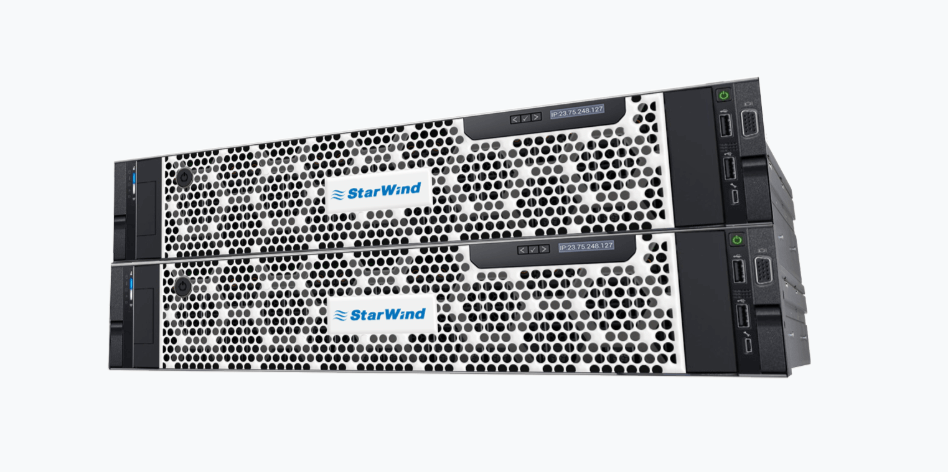The best performing hyperconvergence for every Edge? With the StarWind difference
As organizations grow, there’s a natural progression that leads to an expansion into new markets, new territories, and — in practical terms — to opening local facilities away from where resources have tended to be centralized.
In retail, that expansion is often new stores or outlets; in manufacturing, perhaps the acquisition of parts of the supply chain or logistics operations; for service industries, it’s often local call centers or customer support facilities. Whatever the vertical, every organization now relies on technology to ensure that as the infrastructure expands, it remains manageable and, to a certain extent, retains uniformity in terms of its data and processes.
For the IT department, expansion to new edge deployments represents both opportunity and challenge. There’s a stretching of resources (shortage of skilled personnel, limited network connectivity options, hardware procurement issues, and so on).
Still, at the same time, technologies that prosper in edge settings like IoT offer new ways in which IT can help drive the organization forward.
For local users, clients, and partners that need the services of the remote installation, there are high expectations — ironically, the bar is often set high by IT services in the head office (or central data center) being fast, resilient, and empowering. So, duplicating those levels of care, support, and business empowerment in perhaps dozens of new areas poses IT decision-makers with some crucial questions to consider.
Perhaps just a few years ago, the go-to solution was to ensure that connectivity between the central data center and the remote branch was fast and resilient. Encrypted connections made sure security was maintained, and users experienced little deprecation in quality of service. However, given higher expectations by end-users, better performance of business-critical applications and services, and hybrid cloud topologies, the answer now may have changed.
Unfortunately, it looks like keeping up the standards the enterprise has come to expect means reaching deep into the company coffers.
Deploying local resources like storage area networks, hyperconverged infrastructures, fast backups and restore and massively resilient systems might have seemed like an expensive ideal just a few years ago; a situation in which IT decision-makers had to pick and choose what their priorities were, and gradually cross off the list the ideal elements of the IT infrastructure. Perhaps spinning rust arrays possibly substituted for all-NVMe, and a single hypervisor having to be chosen thanks to expensive and inflexible licensing models.

Source: StarWind
However, here at TechHQ, we’ve been working closely for a couple of years with a supplier of convergent systems that’s changing all that. Where once a full-converged infrastructure was the reality only for the household name multinationals, the StarWind product line has brought tech like plug-and-play HCI and multi-hypervisor VSAN to a position where even the more modest enterprise can roll out infrastructure in remote edge installations.
That’s offering businesses and organizations three significant bonuses. First is the continuation of the standards users might expect as if they were plugged directly into the company headquarters.
Secondly, all the advantages of localized, edge-based storage, compute and connectivity are immediately available, without having to deploy expensive specialist staff (SAN experts, for example) or cripple the procurement budget for the next few years. Thirdly, the StarWind solutions are incredibly speedy to spin up, and every aspect of the company’s offerings is backed by incredibly high levels of support (at no extra cost).
Over the next few articles, we’ll be looking at some of StarWind’s offerings in more detail, and some key aspects to its ethos; like its ability to use COTS hardware to provision highly effective and resilient SANs, its hyperconvergent appliances, and its range of virtualized services, like tape archiving, storage and compute.
One of the more remarkable aspects of StarWind’s value proposition is its use of innovative technology, like grid topology for storage networks. Instead of a “standard” N+1 or N+2 setup, resilience is maintained, even in the event of catastrophic loss of multiple drives. Across the board, there’s an emphasis placed on attenuating and maximizing for the highest levels of speed, reliability, and value — that means edge deployments of what might have been considered data-center only infrastructure can be created quickly and easily on every edge.
All of StarWind’s appliances come pre-built and pre-configured at no extra cost. There is additionally a centralized web dashboard that acts as a single pane of glass into all HCI systems right across the WAN.
In the next few weeks, we’ll be looking at StarWind’s VSAN (RDMI-capable protocols, up to 56GB InfiniBand interconnect fabrics), its free offerings like virtualized tape libraries (and cloud service connection for AWS backups of backups) and how it achieves the massive speeds and resilience it does without having to deploy specialist hardware that costs about the same as a modest dwelling.
In the interim, read more about StarWind and its revolutionary approach that’s stealing customers from the likes of Nutanix and VMware at a speed that’s indubitably alarming those “blue-chip” competitors.









